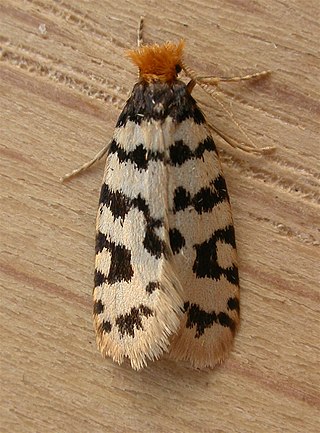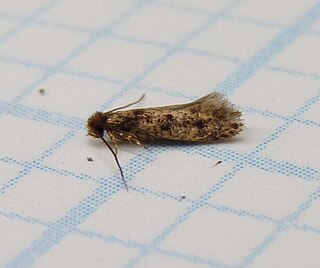
The Psychidae are a family of the Lepidoptera. The bagworm family is fairly small, with about 1,350 species described. Bagworm species are found globally, with some, such as the snailcase bagworm, in modern times settling continents where they are not native.

Phereoeca uterella, known by the vernacular names plaster bagworm and household casebearer, is a moth species in family Tineidae. It occurs in tropical climates, where it is common in houses, and is presumed native to the Neotropical realm. In the Americas, it has been recorded from Brazil, Guyana, and the southern United States as well as the Virgin Islands and Trinidad, and tentatively identified from Tobago.

Lomographa bimaculata, the white-pinion spotted, is a species of geometer moth. It belongs to the large geometer moth subfamily Ennominae, and therein to the tribe Baptini. It is – under its junior synonym – the type species of its genus Lomographa. It is also the type species of Bapta, a junior objective synonym of Lomographa and the namesake of the Baptini. The species was first described by Johan Christian Fabricius ion 1775.

Basiothia medea, the small verdant hawk, is a moth of the family Sphingidae. It is common in open habitats throughout the Ethiopian Region, including Madagascar. It is however probably absent from the equatorial forest belt, except as a vagrant. The species is an active migrant.

Coelonia fulvinotata is a moth of the family Sphingidae first described by Arthur Gardiner Butler in 1875. It is known from most habitats throughout the Afrotropical realm, from the Gambia east to Ethiopia and south to northern South Africa and Madagascar.
Borocera attenuata is a species of Lasiocampidae moth native to Madagascar. It was first described by George Hamilton Kenrick in 1914.
Anania elutalis is a species of moth of the family Crambidae. It was first described by George Hamilton Kenrick in 1917 and is found on Madagascar.
Porthesaroa brunea is a moth of the subfamily Lymantriinae. It is found in central Madagascar.

Glyphodes boseae is a moth of the family Crambidae. It was described by Max Saalmüller in 1880 and it is found in Madagascar.
Thyrosticta dujardini is a moth of the subfamily Arctiinae first described by Paul Griveaud in 1969. It is native to Madagascar.
Thyrosticta bruneata is a moth of the subfamily Arctiinae first described by Paul Griveaud in 1969. It is native to Madagascar.
Epicausis smithiiis a species of moth of the family Noctuidae. It is found in Madagascar.
Sapheneutis pulchella is a species of bagworm moth native to eastern Madagascar.

Typhonia is a genus of moths of the Psychidae family.
Glyphodes paramicalis is a moth of the family Crambidae described by George Hamilton Kenrick in 1917. It is found in Madagascar.
Xanthodesma rectangulata is a moth in the family Noctuidae. It was first described by George Hamilton Kenrick in 1917 and is known from Madagascar.
Calligraphidia tessellata is a moth in the family Noctuidae. It was first described by George Hamilton Kenrick in 1917 and is known from Madagascar.
Sapheneutis is a bagworm genus.

Bactra bactrana is a species of moth of the family Tortricidae. It is found on the Canary Islands, Sicily and Malta and in southern Spain, Portugal, southern Italy, France, Greece, Morocco, Algeria, Egypt, Asia Minor, Arabia, Iraq, Iran, the Caucasus, Afghanistan, the Caspian area, Tajikistan, Kyrgyzstan, Uzbekistan, Pakistan, India, the Republic of Congo, Madagascar, Sudan and Gambia.
Typhonia animosa is a species of bagworm moth first described by Edward Meyrick in 1913. It is found in South Africa.





